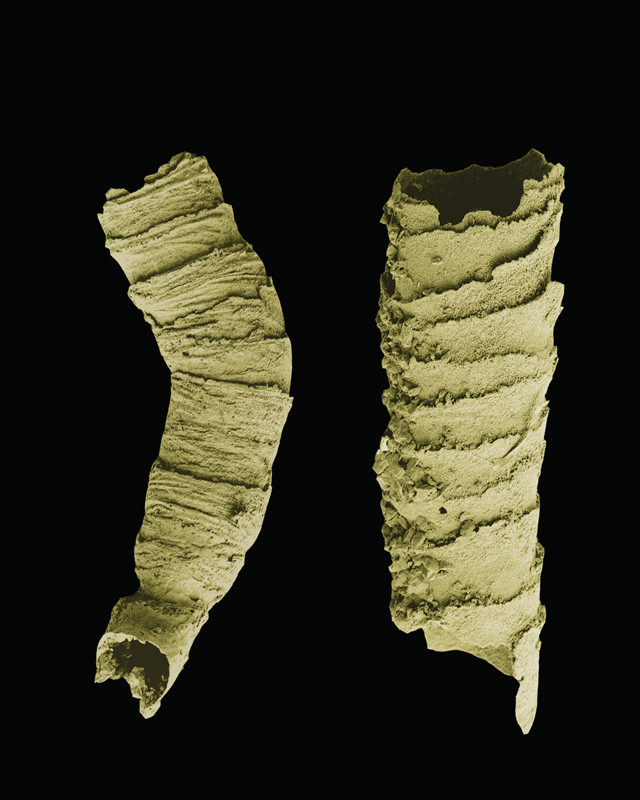
by Lucas Joel Monday, June 19, 2017

Cloudina, one of the earliest-known skeletal animals, was once thought to have lived only in the Ediacaran Period, but it now seems that it lived during the Cambrian as well, implying an earlier history for Cambrian animals. Credit: Shuhai Xiao, Virginia Tech.
The Cambrian Explosion, when the ancestors of most of today’s animal groups began appearing in the fossil record about 542 million years ago, was — as the name suggests — a geologically abrupt event. Paleontologists have long thought of the event as marking a boundary between distinct Precambrian and Cambrian faunas. In new research published in Geology, however, scientists report that small, shelly fossils once thought to occur only in Cambrian rocks have been found in rocks dating to the late Ediacaran, just before the Cambrian, implying an earlier start to the explosion than previously thought.
“We discovered typical Cambrian skeletal fossils associated with typical Ediacaran skeletal fossils in late Ediacaran carbonate in a section by the Yudoma River in eastern Siberia,” says Maoyan Zhu, a paleontologist at the Nanjing Institute of Geology and Palaeontology in China and lead author of the study. “That means a deep root for the Cambrian Explosion of [skeletal] animals.”
One “typical” Cambrian skeletal fossil group, Zhu says, are the small tubular anabaritids, which, based on his team’s findings, are now known to also occur in the late Ediacaran. Conversely, cloudinids, another group of small tubular organisms long thought of as an Ediacaran skeletal group are now also known from the early Cambrian.
This overlap in skeletal forms redefines the explosion, says Rachel Wood, a geobiologist at the University of Edinburgh in Scotland and a co-author of the new study. “The Cambrian Explosion is thought to be a Cambrian phenomenon, but if you take the argument that the Ediacaran and Cambrian biotas now overlap, it means that the beginning of the Cambrian Explosion has to be in the Ediacaran.”
It is unclear, however, whether or not all of the shelly fossils the authors identified in the new study are exactly the same as those found elsewhere on the planet, says Shuhai Xiao, a paleontologist at Virginia Tech who was not involved in the work. One example is Cloudina, the namesake fossil of the cloudinid group: “We don’t really know” if the Cambrian cloudinid fossils the researchers describe are the same Cloudina fossils as those found in, for example, Namibia, which date to the Ediacaran, Xiao says.
Cloudina was long thought to be a reliably Precambrian fossil, says paleontologist Marc Laflamme of the University of Toronto, Mississauga, in Canada, who was also not involved in the work. If a researcher found Cloudina in a rock section, he or she could be sure the rocks were Ediacaran. This is why the researchers need to be sure that the cloudinid fossils they describe are the same as those found elsewhere, he explains. Otherwise, the overlap signal may not be so robust. “The upside is that it demonstrates a need to really go back and do a lot of the taxonomy and stratigraphy in much more detail,” Laflamme says.
The new finds, besides revealing a Precambrian root for Cambrian skeletal fossils, also raise questions about the apparent mass extinction of the Ediacara biota, which includes Earth’s first-known animals. Both skeletal and soft-bodied organisms made up the biota, but most were thought to have perished at the end of the Ediacaran. Now, however, at least for skeletal species, the Cambrian and Ediacaran records overlap, so it appears there was no wholesale extinction, Wood says.
Although a mass extinction among shelly organisms may be in doubt, many members of the Ediacaran biota — particularly soft-bodied ones — did disappear from the rock record before the Cambrian. The reason for this likely relates to overlap between the Cambrian and Ediacaran faunas, Laflamme says: Cambrian-type animals “outcompeted Ediacarans,” he says, and the result was “the ultimate extinction of the Ediacarans.”
But Zhu has a different take: “It is highly probable that we will find overlap of Ediacaran soft-bodied fossils with Cambrian fossils as well,” he says.
However the story evolves, the newfound intermingling of Ediacaran and Cambrian creatures suggests to Wood that the distinctions between the two faunas drawn by scientists in the past “are starting to dissolve.”
© 2008-2021. All rights reserved. Any copying, redistribution or retransmission of any of the contents of this service without the expressed written permission of the American Geosciences Institute is expressly prohibited. Click here for all copyright requests.